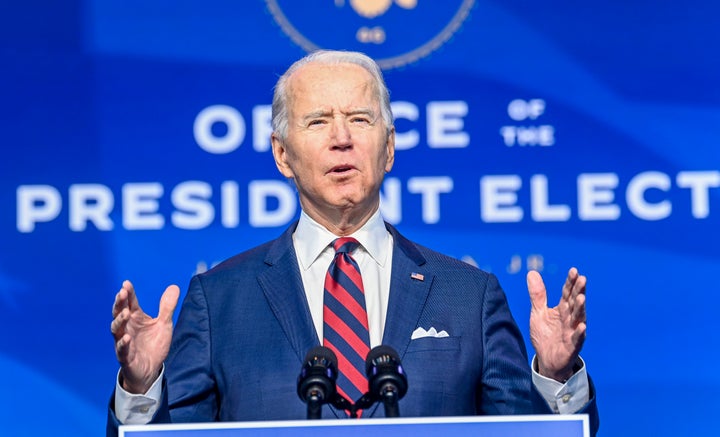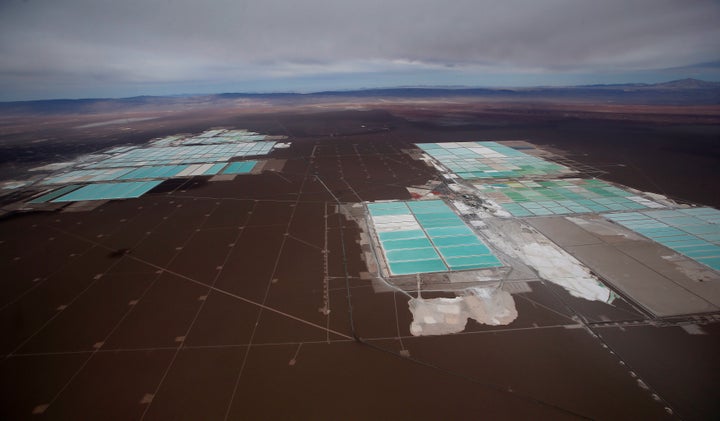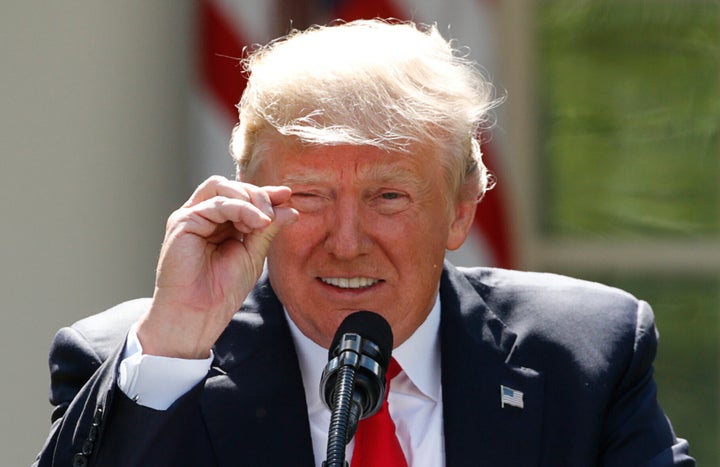Newly inaugurated President Joe Biden ordered his government to begin the process of reentering the climate pact former President Donald Trump exited.
It’s part of a suite of executive orders on climate change, including ones that will block the Keystone XL pipeline and start assessing Trump’s deregulatory legacy.
Hours after his inauguration Wednesday, President Joe Biden signed an executive order to rejoin the Paris Agreement, ending the United States’ brief but symbolic exit from the global pact to slash planet-heating emissions that virtually every nation has joined.
Biden’s executive order kick-starts a relatively simple process. After sending a letter to the United Nations announcing its intentions to reenter the climate accord, the U.S. will again become a formal party to the global negotiations in 30 days.
It was the third executive order he signed in the Oval Office. In separate executive orders, Biden is expected to lay the groundwork for the part that comes next and is much more of a challenge: reversing the Trump administration’s deregulatory legacy and setting ambitious new goals for decarbonizing the U.S. economy.
The executive actions include orders to pull permits for the Keystone XL oil pipeline, reestablish the Interagency Working Group on the Social Cost of Greenhouse Gases, and direct all agencies to immediately review all rules and regulatory guidances enacted under former President Donald Trump.

The new administration has vowed to ramp up domestic climate action, nominating Gina McCarthy, a respected former Environmental Protection Agency administrator and environmentalist, to oversee a transformational domestic agenda aimed at making electric vehicles mainstream and eliminating emissions from the power sector by 2035. He pledged to put the country on course to reach net zero emissions by 2050.
The details of that effort will likely form the backbone of the U.S. Nationally Determined Contribution to the Paris Agreement’s emissions cuts, and give special climate envoy John Kerry, who helped broker the pact as the Obama-era secretary of state, concrete actions to point to as he embarks on his new climate-focused diplomatic mission.

“The ambition that the U.S. is putting forward goes beyond what other countries have added to the mix,” said Ateli Iyalla, the managing director of CDP North America, a nonprofit that tracks carbon disclosures. “We need to be able to show we have the ambition.”
Put Up Real Cash
Simply cutting pollution, however, won’t be enough to restore faith in a politically divided imperial superpower that seesaws between one party that accepts climate science and another that has for nearly two decades now rejected it whole-cloth. Under President Barack Obama, the U.S. pledged just $3 billion to the U.N.’s Green Climate Fund, a pot of money meant to help poor countries adapt to climate change and leapfrog over the fossil fuel phase of economic development. He had delivered just $1.5 billion by the time Trump took office and canceled all future payments.
Increasing payments to that fund could be one way to win back credibility ahead of the U.N. climate summit in Glasgow this year, where nations will convene to reassess emissions cuts and look back on the five years since the Paris Agreement was signed.
Look Hard At ‘Green’ Supply Chains
Another could be prioritizing fair trade agreements with the countries whose raw materials currently fuel the green industrial supply chain. Biden looks likely to boost domestic mining of the materials needed to make solar panels and batteries for electric cars and homes. But the existing supply chains already cause significant environmental destruction overseas.
Lithium mined in Chile uses massive amounts of water in the South American country’s desert regions, while Australia’s toxic hard-rock resource is exported to China for processing, causing pollution. Cobalt mined in the Democratic Republican of the Congo is linked to human rights abuses and mistreatment of informal miners. Indonesia’s nickel mines ― some of the world’s largest ― are a major source of ocean pollution.

The Biden administration could implement new rules to track raw materials and prioritize mass transit over policies to promote electric vehicles, limiting what’s expected to be a meteoric rise in demand.
“The supply chains look like all supply chains under global capitalism: When you go to the extractive frontier, you see the hyper exploitation of labor, contamination of ecosystems and violations of Indigenous rights,” said Thea Riofrancos, a political scientist at Providence College and author of a new book on extractive industries in South America.
“What I would like to see is for the Biden administration to let go of this idea that individual passenger electric vehicles solve climate, embrace a public electrification vision, and be realistic about how the global supply chains are organized right now, so they can lay out a vision of green and just trade,” she added.
Cooperation, Not Cold War, With China
The administration’s trade agenda will hinge significantly on its relationship with China. It faces major obstacles. Ties between the world’s two largest economies reached their lowest point in decades under the Trump administration, which waged a haphazard trade war against China and, in its final days in office, declared Beijing’s brutal repression of its Muslim Uighur minority a genocide. Biden will confront those challenges while both he and Chinese officials face pressure from nationalists at home to intensify what looks increasingly like a cold war between the two countries.
Yet brokering a cooperative peace between the U.S. and China will be key to any global decarbonization plan. Abandoning plans to contain China’s growth and instead working together could help quickly deploy clean energy and climate solutions worldwide, said Jake Werner, a China researcher at Boston University’s Global Development Policy Center. China’s manufacturing capacity for clean energy products is “unmatched” and could be expanded, he said, while the U.S. controls the financial system and boasts an unrivaled network of formal alliances.
“If we want to transition the global economy away from fossil fuels as fast as we need it to, we need China to be doing a lot of the heavy lifting because of how strong its new-energy production capacity is,” Werner said. “The U.S. would be able to move a global Green New Deal diplomatically and would be able to line up financing for it in ways that would be complementary to what China brings to that project.”
Clean Up The U.S.’s Own CO2 Mess
Another novel approach the Biden administration could take to demonstrate its understanding of the U.S.’s disproportionate share of cumulative emissions would be to commit to funding and deploying technologies and policies to remove carbon from the atmosphere. Carbon removal broadly defines a set of approaches that range from nature-based ideas like planting new forests and adopting new soil farming techniques to technological solutions such as direct air capture, machines that suck CO2 from the atmosphere and transform it into a material that can be used in building materials or stored underground.
“The ideal scenario ... is that the U.S. returns to the Paris Agreement not simply ready to enforce stringent emissions standards, but really ready to commit serious research dollars in the short term and deployment dollars in the medium and long term to carbon removal.”
- Olúfẹ́mi O. Táíwò, Georgetown University
Direct air capture is a nascent industry. But over the past two years, tech firms vowing to erase their legacy of climate pollution have stoked new interest, as have oil companies that invested in the technology as a means of extracting more oil and hedging against a future where demand for fossil fuels plummets. If that link to the industry most responsible for climate change weren’t enough to make many environmentalists skeptical of direct air capture, the eye-popping projections for how much energy, water and land such facilities would require to suck CO2 from the sky at scale certainly do.
While there’s debate over how many gigatons of carbon need to be removed from the atmosphere to keep global temperatures from surging past 1.5 degrees Celsius (from roughly 1.2 degrees today), many experts agree on the need to deploy technology like direct air capture. Taking the lead on that costly effort could show developing countries whose poverty and history of colonialism make limits to fossil fuel use politically unpalatable that the U.S. is, in fact, doing its part to clean up its two centuries of pollution.
“The ideal scenario, or at least a better scenario than the one we’re likely to get in the status quo, is that the U.S. returns to the Paris Agreement not simply ready to enforce stringent emissions standards, but really ready to commit serious research dollars in the short term and deployment dollars in the medium and long term to carbon removal,” said Olúfẹ́mi O. Táíwò, a researcher and assistant professor at Georgetown University who recently wrote an essay on why carbon removal would be good for African nations.
There’s earnest scientific debate over how much more carbon dioxide the atmosphere can absorb before locking in 1.5 degrees Celsius of warming. At the end of 2017, U.N. scientists projected that a carbon budget of just 420 gigatons remained, and humanity has roughly spent that at a rate of 42 gigatons per year.
Removing some of that carbon while simultaneously halting increasing emissions would “expand the carbon budget available to developing countries,” Táíwò said.
“Low-income countries, developing countries, and small island states have different things at stake in the climate crisis, so there’s a better rationale for them doing what they need to do even if it means using existing technologies that emit carbon to take care of their populations,” he added. “Places like the U.S. and Canada have contributed an outsize amount of historical emissions that have accumulated in the atmosphere. So there’s a story to tell about responsibility.”

